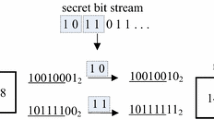Abstract
This paper proposes a new image steganographic method that effectively combines LSB embedding with Octa-PVD embedding. A cover image is divided into non-overlapping 3 × 3 sub-blocks, the n least significant bits of the center pixel of each sub-block is first substituted by secret data (n-LSB substitution). Then, the differences between the center pixel and its eight neighbors are calculated. For each direction, if the difference is equal or larger than a threshold (predefined by users or automatically determined by image analysis), secret data is embedded into the neighbor pixel by n-LSB substitution. Otherwise, secret data is embedded by PVD embedding, but into the neighbor pixel only. Consequently, depending on the conditions of each sub-block, a single embedding method can be used to the whole sub-block, or two embedding methods can be used alternately within a sub-block. Comparisons with existing LSB or multi-directional PVD embedding methods demonstrate that the proposed method has more optimized and higher embedding capacity and PSNR.














Similar content being viewed by others
References
Abdulla AA (2015) Exploiting Similarities Between Secret and Cover Images for Improved Embedding Efficiency and Security in Digital Steganography, PhD Thesis, The University of Buckingham
Abdulla AA, Sellahewa H, Jassim SA (2019) Improving embedding efficiency for digital steganography by exploiting similarities between secret and cover images. Multimed Tools Appl 78:17799–17823
Chan C-K, Cheng LM (2004) Hiding data in images by simple LSB substitution. Pattern Recogn 37(3):469–474
Chang K, Chang C, Huang PS, Tu T (2008) A novel image steganographic method using tri-way pixel-value differencing. J Multimed 3(2):37–44
Darabkh KA, Al-Dhamari AK, Jafar IF (2017) A new steganopraphic algorithm based on multi directional PVD and modified LSB. J Inf Technol Control 46(1):16–36
Felzenszwalb PF, Huttenlocher DP (2004) Efficient graph-based image segmentation. Int J Comput Vis 59(2):167–181
Filler T, Fridrich J (2011) Design of adaptive steganographic schemes for digital images, Proceedings of SPIE, vol. 7880
Fridrich J (2006) Minimizing the embedding impact in steganography, Proceedings of the 8th Workshop on Multimedia and Security, pp. 2–10
Holub V, Fridrich J, (2012) Designing steganographic distortion using directional filters, Proceedings of Fourth IEEE International Workshop on Information Forensics and Security, Tenerife, 2–5 December 2012
Holub V, Fridrich J (2014) Universal distortion function for steganography in an arbitrary domain. EURASIP J Inf Secur. https://doi.org/10.1186/1687-417X-2014-1
Karampidis K, Kavallieratou E, Papadourakis G (2018) A review of image steganalysis techniques for digital forensics. J Inf Secur Appl 40:217–235
Khodaei M, Faez K (2012) New adaptive steganographic method using least significant-bit substitution and pixel-value differencing. IET Image Process 6(6):677–686
Li B, Wei W, Ferreira A, Tan S (2018) ReST-net: diverse activation modules and parallel subnets-based CNN for spatial image steganalysis. IEEE Signal Process Lett 25(5):650–654
Lin D, Dai J, Jia J, He K, Sun J (2016) ScribbleSup: scribble-supervised convolutional networks for semantic segmentation, Proceedings of IEEE Conference on Computer Vision and Pattern Recognition
Lue W, Huang F, Huang J (2010) Edge adaptive image steganography based on LSB matching revisited. IEEE Trans Inf Forensics Secur 5(2):201–214
Modi MR, Islam S, Gupta P (2013) Edge based steganography on colored images. Lect Notes Comput Sci 7995:593–600. https://doi.org/10.1007/978-3-642-39479-9_69
Pevný T, Filler T, Bas P (2010) Using high-dimensional image models to perform highly undetectable steganography, Proceedings of 12th International Conference in Information Hiding (IH), pp. 161–177, Calgary, 28–30 June 2010
Pradhan A, Sekhar LR, Swain G, (2018) Digital image steganography using LSB substitution, PVD, and EMD, Math Probl Eng, 2018, article ID 1804953
Sahu AK, Swain G (2020) Reversible image steganography using dual-layer LSB matching, Sensing and Imaging, 21, article number 1
Swain G (2014) Digital image steganography using nine-pixel differencing and modified LSB substitution. Indian J Sci Technol 7(9):1444–1450
Swain G (2016) A steganographic method combining LSB substitution and PVD in a block. Procedia Comput Sci 85:39–44
Swain G (2018) High capacity image steganography using modified LSB substitution and PVD against pixel difference histogram analysis, Secur Commun Netw, 2018, article ID 1505896
Tang W, Li B, Tan S, Barni M, Juang J (2019) CNN-based adversarial embedding for image steganography. IEEE Trans Inf Forensics Secur 14(8):2074–2087
Thanekar S, Pawar S (2013) Octa (STAR) PVD: A different approach of image steganography, Proceedings of the 2013 IEEE International Conference on Computational Intelligence and Computing Research (ICCIC), Enathi, India
Wu D, Tsai W (2003) A steganographic method for images by pixel-value differencing. Pattern Recogn Lett 24:1613–1326
Wu H, Wu N, Tsai C, Hwang M (2005) An image steganographic scheme based on pixel-value differencing and LSB replacement methods. IEE Proc - Vision Image Signal Process 152(5):611–615
Wu S, Zhong S, Liu Y (2018) Deep residual learning for image steganalysis. Multimed Tools Appl 77(9):10437–10453
Xu G, Wu H (2016) Structural design of convolutional neural networks for steganalysis. IEEE Signal Process Lett 23(5):708–712
Zhang X, Wang S (2006) Efficient steganographic embedding by exploiting modification direction. IEEE Commun Lett 10(11):781–783
Zhanzhan G, Guangming T (2019) A further study of optimal matrix construction for matrix embedding steganography. J Internet Technol 20(1):205–217
Zheng Y, Jeon B, Xu D, Wu QMJ, Zhang H (2015) Image segmentation by generalized hierarchical fuzzy C-means algorithm. J Intell Fuzzy Syst 28(2):961–973
Acknowledgements
This work was supported by the research fund of Signal Intelligence Research Center supervised by Defense Acquisition Program Administration and Agency for Defense Development of Korea.
Author information
Authors and Affiliations
Corresponding author
Additional information
Publisher’s note
Springer Nature remains neutral with regard to jurisdictional claims in published maps and institutional affiliations.
Rights and permissions
About this article
Cite this article
Kang, S., Park, H. & Park, JI. Combining LSB embedding with modified Octa-PVD embedding. Multimed Tools Appl 79, 21155–21175 (2020). https://doi.org/10.1007/s11042-020-08925-3
Received:
Revised:
Accepted:
Published:
Issue Date:
DOI: https://doi.org/10.1007/s11042-020-08925-3




